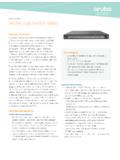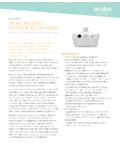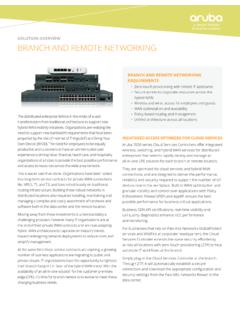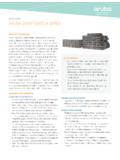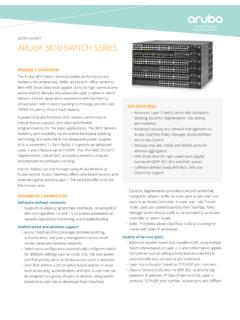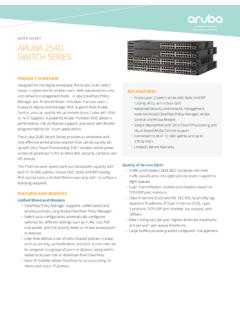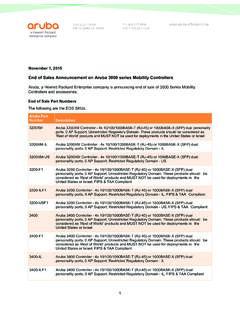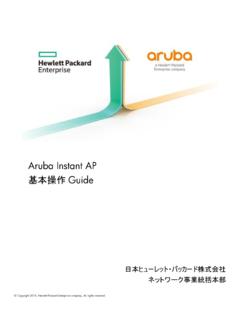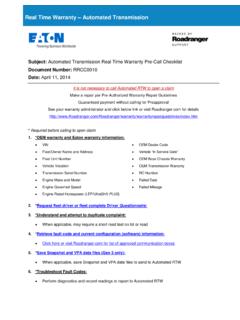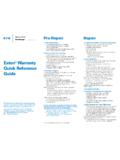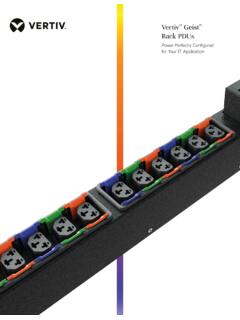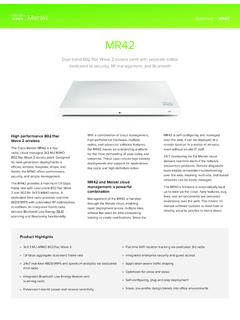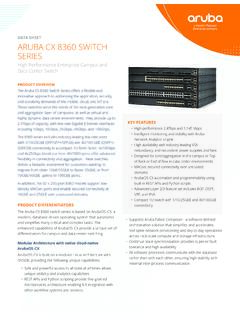Transcription of Aruba CX 8400 Switch Series Data Sheet
1 data SHEETPRODUCT OVERVIEWThe past several decades in networking have been defined by static, closed networking solutions designed for the client-server era. Aruba is introducing the Aruba 8400 campus core and aggregation Switch , a game-changing solution offering a flexible and innovative approach to dealing with the new application, security and scalability demands of the mobile-cloud and IoT era. The 8400 provides industry-leading line rate 10 GbE/40 GbE/100 GbE connectivity in a compact 8 slot chassis. Together with the compact 1U Aruba 8320 Switch Series , the 8400 rounds out Aruba s Mobile First switching portfolio with an enterprise core and aggregation solution that ensures higher performance and higher 8400 is based on the new ArubaOS-CX, a modern software system for the enterprise core that automates and simplifies many critical and complex network tasks, delivers enhanced fault tolerance and facilitates zero-service disruption during planned or unplanned control-plane events.
2 The key innovations in ArubaOS-CX are its micro-services style modular architecture, REST APIs, Python scripting capabilities and the Aruba Network Analytics is based on a modular architecture that allows individual process re-startability and upgrades. Its REST APIs and Python scripting enables fine-grained programmability of the Switch functions and its unique Aruba Network Analytics Engine provides the ability to monitor and troubleshoot the network Network Analytics Engine framework is made up of a time Series database and associated REST time Series database may be used to store configuration and operational state. Customers can use ArubaOS-CX REST APIs, Python scripting capabilities and time Series data to write software modules for trouble shooting problems.
3 The time Series data may also be used to analyze trends, identify anomalies and predict future capacity 8400 Switch SERIESKEY FEATURES High performance terabits per second switching ( ) capacity Carrier-class high availability with redundant management, power and fabric ArubaOS-CX enables automation and programmability using built-in REST APIs and Python scripts Intelligent monitoring and visibility with Aruba Network Analytics Engine Advanced Layer 2/3 feature set includes BGP, OSPF, VRF, and IPv6 Compact 8U chassis with high density, line rate 10 GbE/40 GbE/100 GbE connectivity Multi-chassis link aggregationDATA Sheet Aruba 8400 Switch SERIESFEATURES AND BENEFITSP roduct architecture ArubaOS-CX -Modular, Linux based and built with OVSDB to support a database-centric operating system.
4 -Distributed architecture with separation of data and control planes. -Includes independent monitoring and restart of individual software modules, and enhanced software process serviceability functions. -Allows individual software modules to be upgraded for higher availability. Network Analytics Engine A first of a kind built-in framework for monitoring, troubleshooting and capacity High-speed fully distributed architecture Provides up to Tbps switching capacity with up to billion packets per second (BPPS) for throughput; all switching and routing is performed in the line modules; meets the demands of bandwidth-intensive applications today and in the future Scalable system design Provides investment protection to support future technologies and higher-speed connectivityConnectivity High-density port connectivity Supports up to 8 line modules; a 32-port 10 Gigabit Ethernet with MACsec in HW, an 8-port 40 Gigabit Ethernet, and a 6-port 40/100 Gigabit Ethernet module.
5 Jumbo frames Allows high-performance backups and disaster-recovery systems; provides a maximum frame size of 9K bytes Loopback Supports internal loopback testing for maintenance purposes and an increase in availability; loopback detection protects against incorrect cabling or network configurations and can be enabled on a per-port or per-VLAN basis for added flexibility Packet storm protection Protects against unknown broadcast, unknown multicast, or unicast storms with user-defined thresholdsQuality of Service (QoS) Powerful QoS feature Supports the following congestion actions: strict priority (SP) queuing and weighted fair queuingResiliency and high availability Redundant and load-sharing fabrics, management, fan assemblies, and power supplies Increases total performance and power availability while providing hitless, stateful failover All hot-swappable modules Allows replacement of modules without any impact on other modules Separate data and control paths Separates control from services and keeps service processing isolated.
6 Increases security and performance Passive design system All active chassis components are field replaceable for increased reliability VRRP Allows groups of two routers to dynamically back each other up to create highly available routed environments Unidirectional Link Detection (UDLD) Monitors link connectivity and shuts down ports at both ends if unidirectional traffic is detected, preventing loops in STP-based networks IEEE LACP Supports up to 128 trunks, each with eight links per trunk; and provides support for static or dynamic groups and a user-selectable hashing algorithm Multiple internal power supplies Provides high reliability, requiring only two power supplies to support a fully populated Aruba 8400 and adding two more gives the solution N+N power redundancyVirtual private network (VPN) Generic Routing Encapsulation (GRE) Enables tunneling traffic from site to site over a Layer 3 pathManagement Management interface control Enables or disables each of the following interfaces depending on security preferences.
7 Console port, or reset button Industry-standard CLI with a hierarchical structure Reduces training time and expenses, and increases productivity in multivendor installationsDATA Sheet Aruba 8400 Switch Series Management security Restricts access to critical configuration commands; offers multiple privilege levels with password protection; ACLs provide SNMP access; local and remote syslog capabilities allow logging of all access SNMP v2c/v3 Provides SNMP read and trap support of industry standard Management Information Base (MIB), and private extensions sFlow (RFC 3176) Provides scalable ASIC-based wire speed network monitoring and accounting with no impact on network performance; this allows network operators to gather a variety of sophisticated network statistics and information for capacity planning and real - time network monitoring purposes Remote monitoring (RMON) Uses standard SNMP to monitor essential network functions and supports events, alarms, history, and statistics groups as well as a private alarm extension group TFTP and SFTP support Offers different mechanisms for configuration updates; trivial FTP (TFTP) allows bidirectional transfers over a TCP/IP network.
8 Secure File Transfer Protocol (SFTP) runs over an SSH tunnel to provide additional security Debug and sampler utility Supports ping and traceroute for both IPv4 and IPv6 Network time Protocol (NTP) Synchronizes timekeeping among distributed time servers and clients; keeps timekeeping consistent among all clock-dependent devices within the network so the devices can provide diverse applications based on the consistent time IEEE Link Layer Discovery Protocol (LLDP) Advertises and receives management information from adjacent devices on a network, facilitating easy mapping by network management applications Dual flash images Provides independent primary and secondary operating system files for backup while upgradingLayer 2 switching VLAN Supports up to 4,040 port-based or IEEE VLANs.
9 And supports MAC-based VLANs, protocol-based VLANs, and IP-subnet-based VLANs for added flexibility Bridge Protocol data Unit (BPDU) tunneling Transmits STP BPDUs transparently, allowing correct tree calculations across service providers, WANs, or MANs Port mirroring Duplicates port traffic (ingress and egress) to a local or remote monitoring port; supports 4 mirroring groups, with an unlimited number of ports per group STP Supports standard IEEE STP, IEEE Rapid Spanning Tree Protocol (RSTP) for faster convergence, and IEEE Multiple Spanning Tree Protocol (MSTP) Internet Group Management Protocol (IGMP) Controls and manages the flooding of multicast packets in a Layer 2 network Rapid Per-VLAN spanning tree plus (RPVST+) Allows each VLAN to build a separate spanning tree to improve link bandwidth usage in network environments with multiple VLANsLayer 3 services Address Resolution Protocol (ARP) Determines the MAC address of another IP host in the same subnet; supports static ARPs; gratuitous ARP allows detection of duplicate IP addresses.
10 Proxy ARP allows normal ARP operation between subnets or when subnets are separated by a Layer 2 network UDP helper Redirects UDP broadcasts to specific IP subnets to prevent server spoofing Dynamic Host Configuration Protocol (DHCP) Simplifies the management of large IP networks and supports client; DHCP Relay enables DHCP operation across subnets Domain Name System (DNS) Provides a distributed database that translates domain names and IP addresses, which simplifies network design; supports client and serverDATA Sheet Aruba 8400 Switch SERIESL ayer 3 routing Static IPv4 routing Provides simple manually configured IPv4 routing Open shortest path first (OSPF) Delivers faster convergence; uses link-state routing Interior Gateway Protocol (IGP), which supports ECMP, NSSA, and MD5 authentication for increased security and graceful restart for faster failure recovery Border Gateway Protocol 4 (BGP-4) Delivers an implementation of the Exterior Gateway Protocol (EGP) utilizing path vectors; uses TCP for enhanced reliability for the route discovery process; reduces bandwidth consumption by advertising only incremental updates; supports extensive policies for increased flexibility; scales to very large networks IP performance optimization Provides a set of tools to improve the performance of IPv4 networks.
